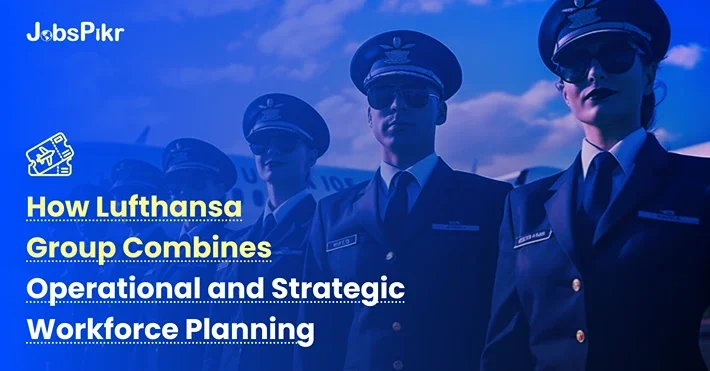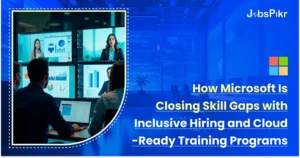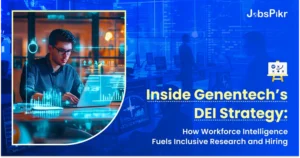Unlike many other industries, airlines operate across borders and time zones and present a complicated regulatory landscape. The workforce is not only large but also very specialized; many job roles are unionized, while these jobs spread all over the huge network of airports, maintenance bases, and corporate offices. Thus, hiring the right person at the right time becomes more of a central business function than an HR activity per se.
This challenge has been increasing in complexity throughout time. Spikes in seasonal travel, abrupt geopolitical shifts, and recently unforeseen global events, such as the COVID-19 pandemic, have created complexities in workforce decision-making, thus demanding agility from it. Therefore, the aviation industry had to move away from the standard methods of planning.

That all takes strategic workforce planning. Not much is left to manage staffing week-to-week. Airlines have to forecast talent needs some months or even years ahead, hence synchronizing their business strategy with people strategy. While doing so, they cannot afford to be distracted from the hour at hand; daily flight schedules, ground operations, and crew availability have to be as punctual as ever.
The Lufthansa Group, being the largest airline group in Europe, presents a good example of how to strike this balance. The group adopts a mix of operational workforce planning and long-term talent strategy the resulting in building a workforce model that is flexible as well as future-ready.
They are not alone, though; the rest of the industry is equally realizing that success in aviation now rests on having an evident, data-driven aviation HR strategy, one that links labor market trends with internal workforce capabilities and demands of the business that are dynamic.
The Operational Planning Layer: Meeting Real-Time Needs
At an airline of Lufthansa’s magnitude, even the smallest disturbances can affect entire continents. A delay in Frankfurt can interfere with the timing of crew arrivals in Mumbai and maintenance in Munich or passengers in New York. This is why operational workforce planning is so vital for their operations.
Operational planning, essentially, is about the now. The intention is to fill the shift, the job, the individual role with the required crew needed for safe and timely service for any flight, the ground-side staff, along with their technical side. It is a highly fast-paced, dynamic, and precision-dependent layer of planning. Lufthansa achieves this through real-time data, scheduling systems, and, increasingly, workforce analytics.
Operational Workforce Planning Brings Order and Flexibility to Lufthansa:
- Staffing Insights in Real Time: Lufthansa applies the most sophisticated workforce analytics with respect to assessing availability and degree of exhaustion of its employees, so they can fast decide on staff reallocation or call in extra replacements without risking safety or service standards.
- Smart Rostering System: Lufthansa employs digital scheduling systems that comply with union agreements, regional labor laws, and even employee preferences to generate optimized schedules that minimize manual intervention and also allow work-life balance for all of their employees.
- Rapid Response to Disruptions: Whenever weather disruptions or technical disruptions take place, the systems of Lufthansa allow them to adjust their manpower needs..
- Data-driven shift planning: Data patterns with recurring overtime, failed-to-file shifts, or last-minute changes are monitored carefully. The immediate decisions are taken with their help, while they can also serve as input in workforce decisions.
This layer of planning may well focus on immediate needs. However, it should never be looked upon as detached from the bigger picture. Every operational decision taken today is also fed back into a broader talent strategy. If the same roles grow perpetually understaffed or overtime trends hit spikes in a particular region, those serve as warning signs for the strategic workforce planning process.
Hence, operational planning is viewed by Lufthansa not as a separate dance performance, but rather as an ongoing pulse check on the health and agility of their workforce system.
The Strategic Planning Layer: Building a Future-Ready Workforce
Operational workforce management ensures airlines carry out daily business, whereas the strategic workforce team prepares the company for future development. For the Lufthansa Group, strategic workforce planning goes beyond just filling job vacancies, it finds out what talents might be needed in the distant future on the rapidly moving aviation industry and prepares the workforce.

At the strategic planning level, talent strategy is aligned with business goals: whether the company is expanding an Asian route, investing in sustainable aviation fuel, or deploying new aircraft models, all these decisions inevitably impact workforce composition on some level. It is, therefore, crucial that Lufthansa looks at this from a future perspective to ensure that they have the right person at the right time, possessing the right skills.
This approach consists of:
- Talent pipeline development: Lufthansa is investing substantially in the development of internal talent through structured training programs and clearly marked career advancement pathways, coupled with mentoring opportunities. This fills critical positions internally, supporting the buildup of institutional knowledge and loyalty.
- Skill gap analysis: The aviation sector has seen an accelerated digital transformation from AI-enhanced operations to predictive maintenance. Lufthansa uses skill gap analysis to comprehend where the present workforce lacks, considering where it needs to hire, to train, or to reskill. For example, higher demands for data analysts and automation engineers.
- Demand forecasting: Lufthansa plans ahead for hiring of people into the various job functions and geographies in anticipation of future demand, using such tools as historical data, business forecasts, and external unemployed labor market insights. By doing this, however, Lufthansa is able to take out the reactive response to hiring and focus on workforce planning instead real paradigm shift in an industry that commonly has long time periods involved in hiring for these roles, like a pilot or engineer.
- Strategic partnerships: The company partners with flight schools, universities, and technical institutes in the development of pipelines for emerging roles. Herein lies the opportunity for Lufthansa to affect curriculum design, so that candidates will be trained with exactly the skills required by the airline.
- Focus on leadership readiness: As another axis of its talent strategy for the long term, Lufthansa identifies high-potential employees and places them on rotation programs across functions and geographies to groom future leaders. It serves to build an agile and globally minded leadership bench.
By continuously focusing on those elements, Lufthansa ensures that strategic workforce planning would not be an HR silo but be an integral part of every major business decision. With aviation still battling talent shortages, regulatory pressures, and tech disruption, an able-for-resilience workforce winds up being a sustainable competitive edge.
Strategic planning does not just safeguard Lufthansa from workforce turbulence for the future; it enables the company to go faster, adapt sooner, and continuously deliver high service quality during turbulence. Such is the power of combining long-run thinking and data-driven workforce strategy.
Bridging the Gap: Lufthansa Group’s Integrated Planning Model
Operational needs and planning for the future are often dealt with in separate arenas. Lufthansa takes the road less traveled. The airline does not consider real-time staffing and long-term talent strategy as separate and distinct functions but rather attempts to integrate these two. The gap between operational workforce planning and strategic workforce planning is what makes its HR model so robust and effective.
By integrating the two layers of planning, Lufthansa ensures that immediate decisions do not contradict the long-term goals but instead focus on each other. Should an operational bottleneck make itself known repeatedly-even a regular shortfall of aircraft technicians in a certain region-it transcends a mere scheduling matter and morphs into a skill gap for which future recruitment and training must be planned.
Here is how Lufthansa fits the pieces of present and future into place:
1. Unified workforce systems:
Lufthansa runs an HRMS that serves as the common platform providing workforce data to HR, Operations, and Finance. This implies that decisions are not taken in silos. Operational planners may access their strategic forecast counterparts, enabling much greater coordination between time horizons and horizontally across departments.
2. Cross-functional collaboration:
Workforce planning at Lufthansa does not rely only on H.R. Finance teams offer budgeting suggestions while the operations team provides the on-ground requirements; business leaders lay out the strategic goals. With this cross-functional model, workforce decisions are aligned with the broader business objectives.
3. Planning scenarios and modeling:
Dynamic modeling tools enable Lufthansa to run “what-if” scenarios. These help them to determine the workforce requirements: what happens if a new route is opened, there is a shortage of pilots, or regulatory changes come into effect? It’s a proactive way for them to prepare for occurring shifts in future workforce needs before they ever become pressing.
4. Data feedback loops:
Real-time data collected from operational activities goes back through strategic planning models. If airport scheduling challenges continue to be reported at a given airport, that is used to modify staffing ratios and drive hiring strategy in that location.

This integrated-planning method keeps Lufthansa fluid while never losing sight of the bigger picture. They can cope with disruption without overcorrecting, meaning their decisions are made with confidence in uncertainty, and balancing workforce costs with service quality.
In the considered matter of timing, the Lufthansa Group has an advantage of an added layer to the operational and strategic levels. They do not merely react to workforce needs; they anticipate them, prepare for them, and build an operating system through which present and future talent needs can be serviced together.
Lufthansa Group’s HR Lessons from Aviation and Beyond

Workforce planning at Lufthansa Group inspires many lessons that may benefit any large organization managing a distributed, high-skill workforce. The principles of integration, data-driven decision-making, and long-term thinking involved in Lufthansa’s model apply everywhere, although the industry may be unique in its complexity.
A few simple lessons can be drawn from Lufthansa’s integrated approach to apply to HR strategy leads, workforce planners, and CHROs:
1. Make operational data strategic input
Real-time workforce data, such as shift gaps, absenteeism rates, or excessive overtime, should not go into daily troubleshooting. Put simply, Lufthansa shows how these signals can become input in long-term planning, urging early action to either close skill gaps or restructure teams before the issues grow further.
2. Break the Company Siloism Between HR and Operations
In many a company, HR and Operations are two different languages-chasing two different KPI’s. Lufthansa’s approach bucks the trend by bringing shared systems and goals into each department. When HR leaders and Operations leaders understand each other’s pain points, their workforce decisions are more aligned and are quick to change when needs arise.
3. Invest in workforce analytics and scenario modeling
Labor modeling tools, based on future scenarios, can be the real game-changer. Predictive models allow Lufthansa Group to verify assumptions and prevent unpleasant surprises. HR teams in other sectors would also be well-advised to engage in similar modeling to prepare for business growth, technology change, or external disruption.
4. Build a dynamic, resilient talent pipeline
Lufthansa is not hiring just for today; rather, it is working with training schools, building leadership, and preparing potential candidates for roles that may not even exist. That foresight helps buffer the business from shocks—an important capability in any transforming industry.
5. Remain competitive by using external labor market intelligence
Lufthansa Group also looks outward as much as it looks inward. By tracking labor availability, salary benchmarks, and new talent hotspots, it ensures that its workforce strategy still holds within real-world trends. Such an external view can be set with the help of platforms like JobsPikr that offer talent intelligence and global labor market insights.
As industries feel a shortage of talent, digital disruption, and growing pressure to align workforce strategies with business growth, let us learn from the example of Lufthansa: Strategic workforce planning and operational workforce planning do not just exist together; they work harmoniously together.
For HR leaders wanting to build future-ready organizations, integration of both layers of planning is no longer an option. It is the very foundation for workforce excellence.
Toward a Unified Workforce Strategy
The aviation industry is famous for being complicated. It is complex, global, and dynamic. That is where workforce-planning strategies are compared for real-world development. The Lufthansa Group has demonstrated that the real success is neither choosing between operational agility and long-term planning; instead, it lies in uniting the two within one workforce strategy.
By investing in both operational agility and long-term talent development, Lufthansa has constructed a model that is resilient rather than reactive. It does not wait for disruptions to force a change; instead, it tries to forecast needs, utilizes workforce analytics, and demand forecasting in order to stay ahead, meanwhile, making sure that its people are empowered, ready, and aligned with business goals.
The integration does not happen overnight; it requires the right technology, strong collaboration across departments, and a culture that values data as much as experience. Nonetheless, the payoff is huge: continuity of service, better decisions on staffing, and better responses to disruptions, on a daily basis and on a global level.
For workforce planners and CHROs worldwide, Lufthansa’s case offers a practical roadmap. If you want to have a workforce that works for them, this is a case worth studying.
With the right external insights, such as the global labor market intelligence from platforms like JobsPikr – the roadmap can be taken a step forward. Internal data, merged with real-world trends, provides better analysis and better clarity even toward the most complex workforce challenges.
While the uncertainty has been certain, one has been clear: workforce strategy can no longer be living in two separate silos. As exemplified by Lufthansa, the integration of operational workforce planning and strategic workforce planning is the key to manufacturing an organization that can take on anything.
Use JobsPikr’s labor market insights to boost your talent data strategy. Get started with JobsPikr today.




